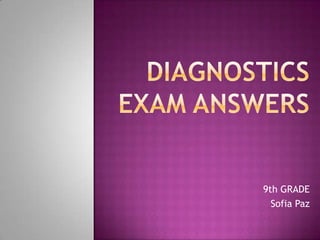9th biology diagnostics exam answers
•Télécharger en tant que PPTX, PDF•
1 j'aime•503 vues
Signaler
Partager
Signaler
Partager

Recommandé
Contenu connexe
Tendances
Tendances (8)
Similaire à 9th biology diagnostics exam answers
Similaire à 9th biology diagnostics exam answers (20)
Under the microscopeCORE273 Summer2019What is Biology.docx

Under the microscopeCORE273 Summer2019What is Biology.docx
Tissues made by ayush dabra class ix roll no. 9311

Tissues made by ayush dabra class ix roll no. 9311
Plus de Sofía Paz Mogro
Plus de Sofía Paz Mogro (12)
Dernier
Dernier (20)
NO1 Top Black Magic Specialist In Lahore Black magic In Pakistan Kala Ilam Ex...

NO1 Top Black Magic Specialist In Lahore Black magic In Pakistan Kala Ilam Ex...
Salient Features of India constitution especially power and functions

Salient Features of India constitution especially power and functions
Plant propagation: Sexual and Asexual propapagation.pptx

Plant propagation: Sexual and Asexual propapagation.pptx
Exploring_the_Narrative_Style_of_Amitav_Ghoshs_Gun_Island.pptx

Exploring_the_Narrative_Style_of_Amitav_Ghoshs_Gun_Island.pptx
HMCS Max Bernays Pre-Deployment Brief (May 2024).pptx

HMCS Max Bernays Pre-Deployment Brief (May 2024).pptx
ICT Role in 21st Century Education & its Challenges.pptx

ICT Role in 21st Century Education & its Challenges.pptx
Unit 3 Emotional Intelligence and Spiritual Intelligence.pdf

Unit 3 Emotional Intelligence and Spiritual Intelligence.pdf
UGC NET Paper 1 Mathematical Reasoning & Aptitude.pdf

UGC NET Paper 1 Mathematical Reasoning & Aptitude.pdf
Fostering Friendships - Enhancing Social Bonds in the Classroom

Fostering Friendships - Enhancing Social Bonds in the Classroom
General Principles of Intellectual Property: Concepts of Intellectual Proper...

General Principles of Intellectual Property: Concepts of Intellectual Proper...
Interdisciplinary_Insights_Data_Collection_Methods.pptx

Interdisciplinary_Insights_Data_Collection_Methods.pptx
Basic Civil Engineering first year Notes- Chapter 4 Building.pptx

Basic Civil Engineering first year Notes- Chapter 4 Building.pptx
Python Notes for mca i year students osmania university.docx

Python Notes for mca i year students osmania university.docx
9th biology diagnostics exam answers
- 2. CELLS come together to form tissues.
- 3. ORGANS come together to form systems.
- 4. The NERVOUS system sends and receives body messages.
- 5. LIGAMENTS hold bone to bone at joints.
- 6. ENDONS hold muscles to bones.
- 7. Cell An biological unit of all organisms An autonomous self-replicating unit that may exist as functional independent unit of life (as in the case of unicellular organism), or as sub- unit in a multicellular organism (such as in plants and animals) that is specialized into carrying out particular functions towards the cause of the organism as a whole.
- 8. Tissue An aggregate of cells in an organism that have similar structure and function. Tissues work in unison to carry out a specific set of functions form an organ. The fundamental types of tissues in animals are epithelial, nerve,connective, muscle, an d vascular tissues whereas in plants, they are the meristematic (apical meristem and cambium), protective (epidermis andcork), fundamental (parenchyma, collenchyma an d sclerenchyma) and vascular (xylem and phloem) tissues.
- 9. Organ A group of tissues that perform a specific function or group of functions, and belongs to an organ system.
- 10. Trachea The windpipe. A fibrocartilaginous tube lined with mucous membrane passing from the larynx to the bronchi.
- 11. Arteries blood vessel carrying blood away from the heart, walls have smooth muscle and are innervated by the sympathetic nervous system. A blood vessel that carries blood from the heart to the body. An artery carries large volumes of oxygenated blood to the major organs of the body.
- 12. Veins Blood vessel that returns blood from the microvasculature to the heart, walls thinner and less elastic than those of artery.
- 13. Capillary Any one of the minute vessels that connect the arterioles (thin arteries) and venules (thin vains), forming anetwork in nearly all parts of the body. Their walls act as semipermeable membranes for the interchange of various substances, including fluids, betwee n the blood and tissue fluid
- 14. Smooth muscle muscle tissue in vertebrates made up from long tapering cells that may be anything from 20-500m long. smooth muscle is generally involuntary
- 15. Organism An individual living thing that can react to stimuli, reproduce, grow, and m aintain homeostasis. It can be a virus, bacterium, protist, fungus, plant or an animal.
- 16. How do cells multiply?
- 18. Name 4 types of primary tissues and explain briefly their main role. Epithelial tissue (skin,digestive tract, reproductive tract…): Protection, absorption,elimination of waste product Connective tissue(blood, bones…): support and bind other tissues as well as they give shape to organs and holds them in place. Muscle tissue (muscles, including cardiac muscle…): locomotion or movements within internal organs. Nervous tissue (brain,spinal cord, nerves…)
- 19. Which is the largest organ in our body and which is its role. the skin is often known as "the largest organ of the human body". This applies to exterior surface, as it covers the body, appearing to have the largest surface area of all the organs. Moreover, it applies to weight, as it weighs more than any single internal organ, accounting for about 15 percent of body weight. For the average adult human, the skin has a surface area of between 1.5-2.0 square meters, most of it is between 2-3 mm thick. The average square inch of skin holds 650 sweat glands, 20 blood vessels, 60,000 melanocytes, and more than a thousand nerve endings
